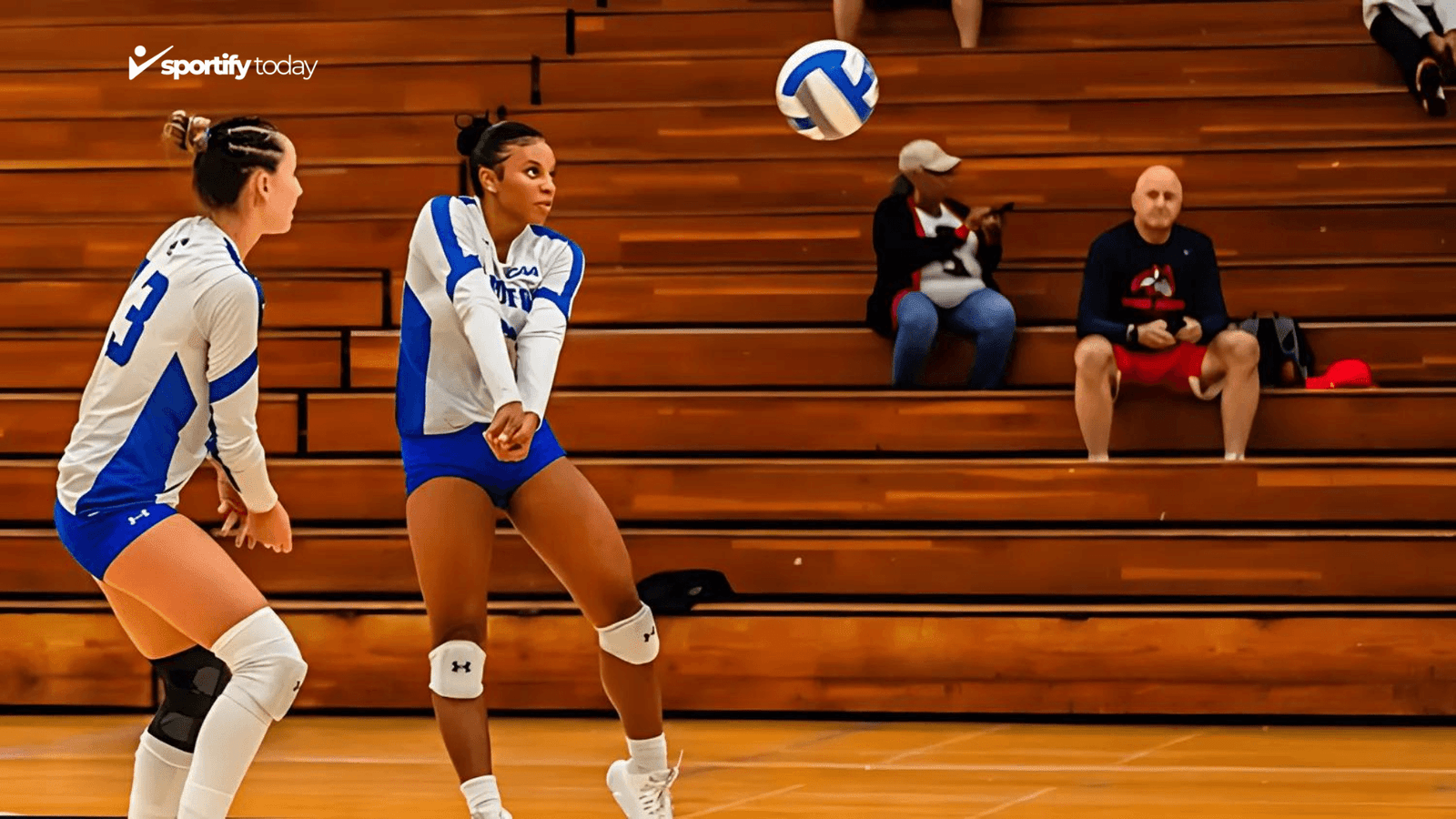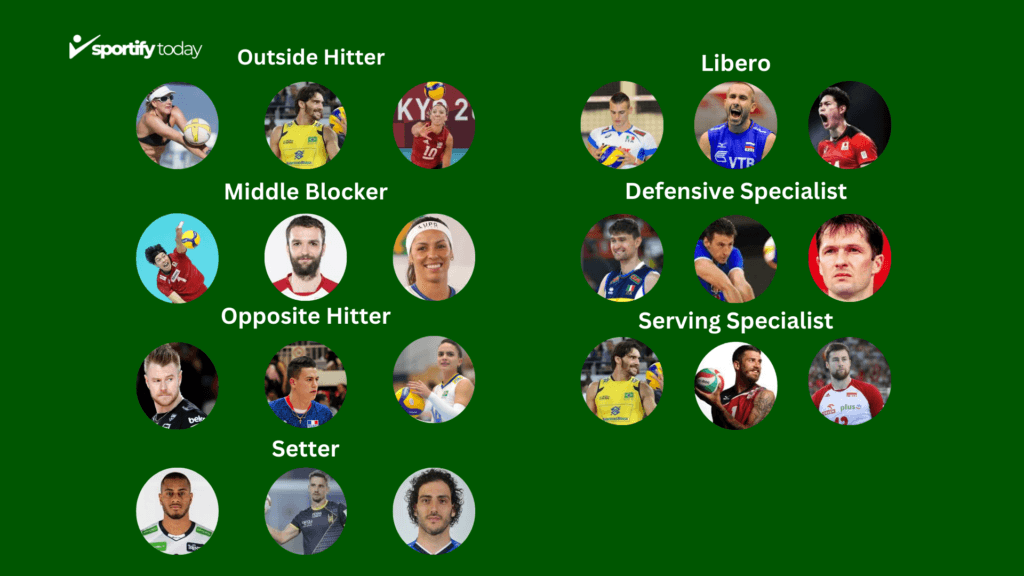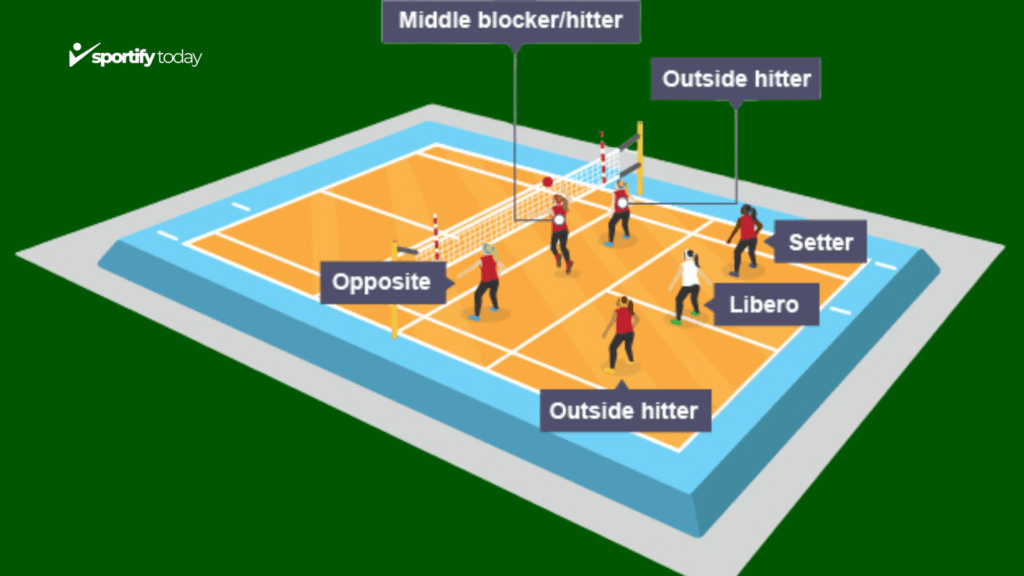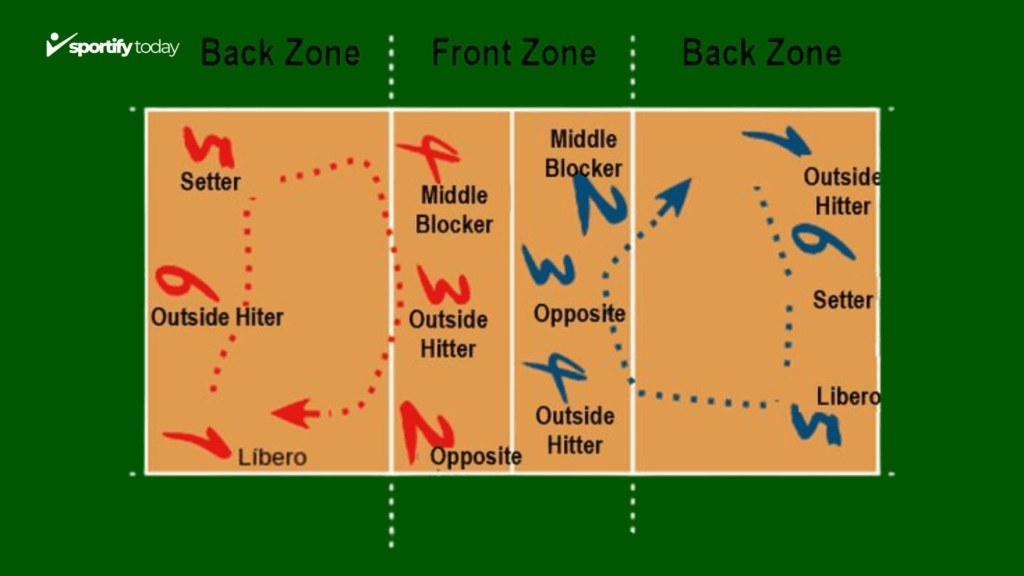
Introduction
Volleyball is a fast game, needs speed, teamwork, strategy, and acquaintance with each role on court for the player. For the rookie players, the knowledge about different positions and their Volleyball Positions And Names For Beginners an important role in efficient gameplay and ultimately to the success of the overall team. This guide will help you understand the best positions for beginners, the seven key positions in volleyball, starting positions, and the five basic positions.

| Outside Hitter | Kerri Walsh Jennings (USA), Giba (Brazil), Jordan Larson (USA) |
| Middle Blocker | Shinji Koshikawa (Japan), Mateusz Mika (Poland), Paula Pequeno (Brazil) |
| Opposite Hitter | Ivan Zaytsev (Italy), Jenia Grebennikov (France), Natasha Osmokrova (Russia) |
| Setter | Lucarelli Santos (Brazil), Marcelinho Ramos (Brazil), Alessandro Fei (Italy) |
| Libero | Gianelli (Italy), Sergey Tetyukhin (Russia), Libero Nishida (Japan) |
| Defensive Specialist | Oleg Antonov (Russia), Vladimir Grbic (Serbia), Jonatan Kwiecinski (Poland) |
| Serving Specialist | Giba (Brazil), Matt Anderson (USA), Michal Kubiak (Poland) |
Volleyball Positions

In volleyball, there are typically six primary positions on the court during gameplay. And all of the positions have a different role and responsibility while playing the game that finally add up to success for the overall team. The following is an overview of the six major positions
| Outside Hitter | Primary attacker; key in offense and defense; involved in serve reception and blocking. |
| Middle Blocker | Blocks opponent’s attacks; vital for net defense and quick attacks. |
| Opposite Hitter | Strong attacker; plays a role in blocking; positioned opposite the setter. |
| Setter | Delivers accurate sets; controls the pace of the game; crucial for offensive plays. |
| Libero | Specializes in digging and receiving serves; vital for back-row defense. |
| Defensive Specialist | Enhances defensive capabilities; substitutes for weaker defenders. |
| Serving Specialist | Delivers powerful serves; may be substituted in for serving situations. |
Best Position in Volleyball for Beginners
For beginners, the Outside Hitter is often considered one of the best positions to start with. This position has a lot to develop in a player, including hitting, passing, and digging. In most cases, outside hitters participate in both offense and defense and thus provide an all-rounded experience, enabling them to understand the game very well. Additionally, the Libero position is also a great option for beginners, as it focuses primarily on defensive skills and serve reception without the pressure of attacking plays. They are also called as Five Basic Positions of Volleyball
1. Setter
Role: This is the player responsible for making precise sets to the external hitters and organizing offensive plays.
2. Outside Hitter
Role: The only one is the primary attacker who usually hits from the left side of the court, plays a central position during both offence and defense, and is usually the same player.
3. Middle Blocker
Role: Positioned at the net, responsible for blocking opposing attacks and executing quick offensive plays.
4. Opposite Hitter (Right Side Hitter)
Role: Plays opposite the setter and contributes to both offense and defense, often attacking from the right side.
5. Libero
Role: A specialized defensive player focused on receiving serves and playing defense, wearing a different color jersey.
6. Defensive Specialist
Role: He is similar to a libero, but his specialty is on defense and reception of the serve, though he is tolerated to go forward.
Optional Positions
In addition to the six primary positions, there are optional roles that teams may utilize based on their strategy:
Serving Specialist: A player who is substituted in specifically to serve, often possessing a strong serve to challenge the opponent.
Key Responsibilities
Defensive Specialist
This is a main position mainly responsible for playing defense. The role is usually that of receiving serves and defending attacks from the opposing teams.
They are often the ones passing to the setter as the play starts.
Serve Reception
Liberos are typically positioned in the back row to receive serves from the opposing team.
Their ability to accurately pass the ball is vital for setting up successful offensive plays.
Covering the Court
The libero must be agile and quick, covering the court effectively to respond to attacks and ensure that no balls drop.
They often have trouble predicting when the other team will hit and positioning themselves appropriately.
Substitutions
Libero substitutions do not count against a team’s limit of substitutions
They come into the game mainly to replace a starting player along front row, such that the team will continue to keep the strongest lineup for defense.
Communication
Effective communication with teammates is essential for a libero. They must call for the ball and direct players on court coverage.
Their leadership in the back row helps organize the defense and ensures everyone is aware of their responsibilities.
Skills Required
Passing and Digging: Liberos must have exceptional passing skills to deliver accurate sets to the setter. They also need strong digging techniques to effectively handle attacks from opponents.
Agility and Quickness: The libero has to move pretty fast and rapidly change direction as they see the ball is in play, therefore having to cover large portions of the court.
Game awareness: A good libero is supposed to have a good knowledge of the game, which he can interpret to foresee the plays and react.
Remaining Calm Under Pressure: Liberos play in pressure situations regularly. Composure is what allows one to execute precise passes and defense plays..
7 Positions in Volleyball
| Role | Delivers powerful serves to pressure opponents. |
| Key Skill | Mastery of jump and float serves for advantages. |
| Game Impact | Can change momentum with well-executed serves. |
| Playing Time | Substituted in for serving situations; usually sub out after serving. |
Volleyball encompasses a range of positions, each with distinct roles and responsibilities that play a vital part in the team’s overall performance. Below are the seven essential positions in volleyball.
Setter: He is in a very good position to make pivotal plays, because he generally controls the accurate set up delivered to the hitter and coordinates with the offense.
Outside Hitter: This is the main attacker who hits from the left side of the court, playing a very significant role both on offense and defense.
Middle Blocker: Positioned at the net, responsible for blocking opposing attacks and executing quick offensive plays.
Opposite Hitter (Right Side Hitter): Plays opposite the setter and contributes both offense and defense, usually attacking on the right side.
Libero: A specialized defensive player who primarily receives serves and plays defense, wearing a different color jersey.
Defensive Specialist: Similar to the libero but can play in the front row, focusing on defense and serve reception.
Serving Specialist: An optional position that comes in specifically to serve, often possessing a strong serve to challenge the opponent.
Starting Position in Volleyball

In volleyball, players typically start in a specific rotation based on their position. The starting position is crucial for establishing effective court coverage and communication. Players must be aware of their designated starting spots and be ready to move quickly as the play develops.
| Front Row | Players at the net, responsible for blocking and attacking. |
| Back Row | Players focusing on defense and serve reception. |
| Libero Position | Defensive specialist, cannot attack above the net height. |
| Setter Position | Ready to set up plays when transitioning to offense. |
| Serving Specialist | Substituted in for strong serves to pressure the opponent. |
Rotation Order
It is a clockwise turn from right back of the server to right front, middle front, and around to the left front and then round to left back, finally all the way back to the right back position. It spins this way throughout the game because players change places after every rally.
Starting Positions of Volleyball Explained
Each position on the court has a designated starting spot. Here’s where each player typically starts
Moves to the front row to set the ball for the hitters.
Right Back (Server)
Starts in the right back corner of the court, behind the attack line.
Serves the ball to start the rally.
Right Front
Starts in the front right corner of the court, near the net.
Responsible for blocking and attacking from the right side.
Middle Front
Starts in the middle of the front row, near the net.
Focuses on blocking and quick attacks at the center of the net.
Left Front (Outside Hitter)
Starts in the left front corner of the court, near the net.
The primary attacker who hits from the left side of the court.
Left Back
Starts in the left back corner of the court, behind the attack line.
Responsible for passing and digging in the back row.
Right Back (Setter)
Starts in the right back corner of the court, behind the attack line.
| Outside Hitter | Leading scorer in the FIVB World Championships; Gold Medal in Olympic Games; Best Outside Hitter award. |
| Middle Blocker | Best Blocker award in World League; Top blocker in club championships; Gold Medal in World Cup. |
| Opposite Hitter | Top Scorer in Volleyball Nations League; Best Opposite Hitter at World Grand Prix; World Championship Gold Medal. |
| Setter | Best Setter award in FIVB World Grand Champions Cup; Gold Medal in Olympic Games; Top Setter in World Cup. |
| Libero | Best Libero award in World League; Top Libero in World Cup; Gold Medal in Olympic Games. |
| Defensive Specialist | Top Defensive Player in Volleyball Nations League; Best Defensive Specialist in tournaments; Key contributor to team success. |
| Serving Specialist | Top Server award in World League; Best Serving Performance in World Championships; Critical serving moments in Olympic Games. |
Key Insights on Volleyball Positions
- Understanding Roles: Each position has specific responsibilities that are vital to the team’s strategy.
- Diverse Skills: Different positions require unique skill sets, such as decision-making for setters and attacking for outside hitters.
- Teamwork is Crucial: Effective communication and collaboration among players are essential for success.
- Position Flexibility: Learning multiple positions enhances player versatility and game understanding.
- Specialized Roles: Roles like libero and serving specialist focus on specific skills, emphasizing the importance of specialization.
- Continuous Improvement: Mastery of a position demands consistent practice and skill refinement.
- Enjoyment of the Game: Embracing various positions contributes to a more enjoyable and fulfilling volleyball experience.
Conclusion: Volleyball consists of several important positions, such as setter, outside hitter, middle blocker, and libero, each serving a unique role that contributes to the team’s overall success. For beginners, grasping these positions and their responsibilities is crucial for improving gameplay and fostering effective teamwork on the court.
People also ask
1. How to play volleyball?
In volleyball, two teams of six players compete to score points by hitting a ball over a net into the opponent’s court, starting with a serve. Each team is allowed three touches to return the ball, and players rotate positions after winning the serve.
2. what is Volleyball Regulations?
Volleyball is played by two teams of six players who score points by grounding the ball in the opponent’s court or forcing errors, with a maximum of three touches allowed to return the ball. Players rotate clockwise after gaining the serve, and the first team to reach 25 points by at least two points wins the set.
Also read: All About Volleyball Positions And Roles

Leave a Reply